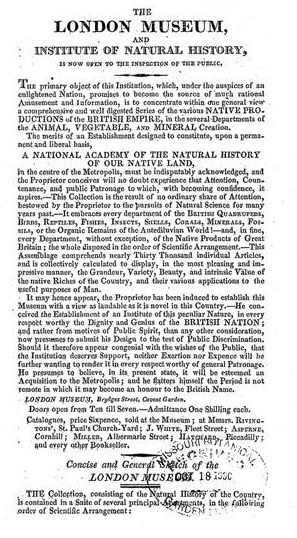London Museum and Institute of Natural History facts for kids
The London Museum and Institute of Natural History was a special private museum in London that opened in 1807. It was a place where people could pay to see amazing collections of plants, animals, and other natural wonders.
Contents
A Peek into the Past: The London Museum
This museum was founded by a man named Edward Donovan. It was located on Catherine Street, near the famous Strand area in London, England. Unlike some other museums of its time, this one was a private business. This meant it was owned by an individual, not the government.
Edward Donovan wanted to create a place where people could learn about the natural world. He made sure the museum was open to the public, even though visitors had to pay a fee.
What Made This Museum Special?
The London Museum and Institute of Natural History was unique because it focused mainly on things found in Great Britain. While other museums might collect items from all over the world, Donovan's museum celebrated the natural history of his own country.
The collections were also arranged in a very scientific way. They followed the Linnaean system. This system was created by a scientist named Carl Linnaeus. It's a way of organizing living things into groups based on their shared features. Think of it like sorting your toys into categories: all the cars together, all the action figures together, and so on. This made the museum very educational.
Exploring the Collections: What You Could See
Imagine walking into the museum! You would have seen hundreds of display cases filled with incredible specimens. There were British mammals, birds, reptiles, and fish. You could also find many insects, shells, and corals.
The museum also had collections of minerals and fossils. Fossils are the remains of ancient life, like bones or plants turned into stone. The museum's catalogue from 1808 said it had "nearly thirty thousand individual articles." That's a huge number of items!
The museum was even called "a national academy of the natural history of the country." Its section on plants, known as botany, was thought to be the most complete collection of British plants anywhere.
Sharing Knowledge: Books and Closure
Edward Donovan was not just a museum owner; he was also a writer. The museum helped him sell his beautifully illustrated books about natural history. These books were based on the very specimens you could see in the museum.
Sadly, the London Museum and Institute of Natural History closed its doors in the spring of 1817. The following year, in 1818, all its amazing contents were sold off at an auction.


